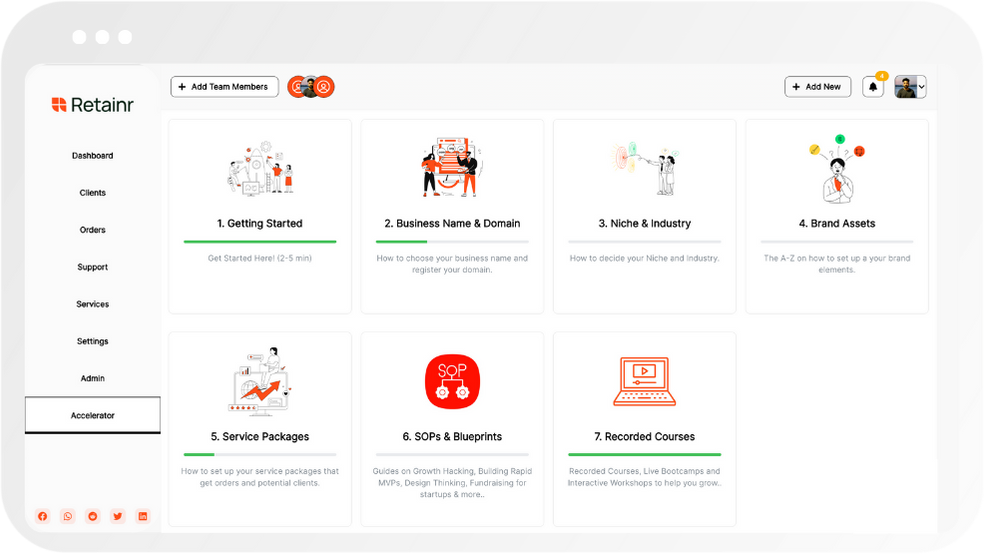
How to Use Long-Tail Keywords for Ecommerce SEO
Build with Retainr
Sell your products and services, manage clients, orders, payments, automate your client onboarding and management with your own branded web application.
Get Started1. What is a long-tail keyword and how is it used in eCommerce SEO?
What is a Long-Tail Keyword?
Long-tail keywords are specific phrases typically consisting of three to five words that your potential customers are probably searching for. These keywords are so called because they fall in the tail end of the search demand graph, indicating their lower competition and higher targeted value. They are typically less popular, less competitive, and consequently, less expensive than generic keywords (head terms).
Use of Long-Tail Keywords in eCommerce SEO
Long-tail keywords play an important role in eCommerce SEO for several reasons:
- Less Competition: As these keywords are more specific, there are fewer websites competing for them.
- Targeted Traffic: People searching with long-tail keywords often know exactly what they're looking for. If your site matches their search, it's likely they'll become customers.
- Increased Conversion: Long-tail keywords generally lead to higher conversion rates, as they target users farther down the sales funnel.
- Ease of Ranking: It's significantly easier to rank for long-tail keywords compared to shorter, more generic keywords.
Demonstrating use of Long-Tail Keywords in a Table
Consider the following truck rental example to understand better.
| Generic Keyword | Long-Tail Keyword |
|---|---|
| Truck Rental | Cheap truck rental in San Francisco |
| Rent a truck | Rent a moving truck for a day |
| Truck hire | Weekend truck hire services |
The table demonstrates that long-tail keywords are far more detailed and are therefore much more likely to be used by customers looking to make a purchase or avail a service.
2. Why are long-tail keywords important for the SEO strategy of an eCommerce website?
Importance of Long-Tail Keywords in eCommerce SEO Strategy
Long-tail keywords play a pivotal role in the Search Engine Optimization (SEO) strategy of an eCommerce website. The first significance lies in the competitive edge they offer. As compared to the common and broad keywords, long-tail keywords hold lower competition. This is because they are more specific and primarily used by fewer websites.
- Lower Competition: With fewer websites using specific long-tail keywords, there is a higher probability for your eCommerce site to rank higher on search engine results pages (SERPs).
- Specific Searches: Long-tail keywords are typically used by consumers who have a clear idea about what they are looking for, leading to more targeted traffic to your site.
The second aspect is the high conversion rate they bring. As these keywords are more specific, they attract users who are further down the sales funnel and hence more likely to make a purchase.
| Keyword Type | User's Buying Intent |
|---|---|
| Generic Keywords | Low |
| Long-Tail Keywords | High |
Finally, they considerably improve the site's user experience. Through long-tail keywords, users are led directly to what they're looking for, resulting in a better UX, which search engines favour. Therefore, incorporating long-tail keywords becomes an integral part of an effective eCommerce SEO strategy to gain enhanced visibility and increased conversions.
3. How do I research and choose the right long-tail keywords for my eCommerce business?
Step 1: Understanding Your Business Niche
Before you begin researching for long-tail keywords, you need a clear understanding of the specific niche your eCommerce business caters to. Not only does this determine your customer base but also governs the kind of long-tail keywords you will use. Look into the following:
- Your product categories
- Unique selling propositions (USPs)
- Common descriptors used by clients
Step 2: Conducting Keyword Research
Once you've fully grasped your business niche, you can go ahead and generate a list of potential long-tail keywords. There several online tools available for long-tail keyword research like Google Keyword Planner, Ahrefs, SEMRush, and KWFinder. Here's a simple way to streamline your process:
| Step | Actions |
|---|---|
| Create a seed keyword list | Base this on the product categories and USPs identified earlier. |
| Run through a keyword tool | Enter these seed keywords into your chosen keyword tool to generate long-tail variations. |
| Analyse results | Review each keyword for its average monthly search volume and competition level. |
| Select suitable keywords | Choose long-tail keywords that have a decent search volume and low competition. |
Step 3: Leveraging Competitor Analysis
Another smart way to discover profitable long-tail keywords for your eCommerce business is by analyzing your competitors. Find out what keywords they're ranking for and include them in your list. Follow the steps below:
- List down your top competitors.
- Run their URLs through a keyword tool or an SEO tool.
- Identify the long-tail keywords they're ranking for.
- Add the relevant ones to your keyword list.
Note: Your main goal should always be to improve your website's visibility and increase organic traffic. Thus, avoid stuffing your content with keywords; use them naturally and moderately.
4. Can you give examples of effective long-tail keywords for eCommerce SEO?
Examples of Effective Long-Tail Keywords for ECommerce SEO
To better grasp the concept of long-tail keywords, let's look at some practical examples for eCommerce search engine optimization. If you were a seller of shoes, your primary keyword could be 'shoes'. However, this is a highly competitive keyword. To narrow down the competition and attract more targeted traffic, you could use long-tail keywords.
- 'red nike running shoes for men'
- 'black leather office shoes for women'
- 'kids' waterproof hiking boots'
These keywords target a specific searcher intent and are likely to attract buyers. Similarly, for an eCommerce platform dealing in electronics, the primary keyboard could be 'electronics'. Here are some long-tail keyword examples for such a business:
- 'latest Samsung smart TV with price'
- 'buy Apple iPhone 12 Pro Max online'
- 'Dell Laptop Inspiron 15 3000 series'
| Primary Product | Potential Long-Tail Keywords |
|---|---|
| Watches | 'Seiko automatic watches for men', 'buy Rolex ladies watches online' |
| Furniture | 'modern wooden dining table sets', 'buy white leather sofa online' |
| Books | 'buy mystery thriller books online', 'latest romance novels by Nora Roberts' |
These examples clearly show how using long-tail keywords can help eCommerce businesses target specific customer queries and improve their SEO ranking. The key is to think like your customer and anticipate their search behavior. This strategy can significantly improve your online visibility and drive quality traffic to your website.
5. What are the benefits of using long-tail keywords in my eCommerce SEO efforts?
Enhanced Targeting and Less Competition
Long-tail keywords are highly specific to your products or services. They are a comprehensive description of your offerings which means they will be targeting a reduced but more precise audience. This direct and clear approach significantly reduces competition as not many companies will be using the same long-tail keywords.
- Long-tail keywords increase the chances of your page showing up in relevant search results
- They significantly reduce the competition level as compared to short, general keywords
Improved Conversion Rates
Arguably, the most significant advantage of using long-tail keywords in your eCommerce SEO efforts is the potential increase in conversion rates. Since these keywords target a specific group of consumers who know what they want, there’s a higher likelihood that they will convert into paying customers. Below is a simple comparison table illustrating the impact of long-tail keywords on conversion rates.
| Keyword Type | Conversion Rate |
|---|---|
| General Keywords | 1-2% |
| Long-tail Keywords | 3-5% |
Better Customer Connection
Long-tail keywords allow you to connect better with your customers. By using highly specific keywords, you are answering a user’s specific query. It demonstrates that you understand and can provide precisely what they are looking for, enhancing your connection with them.
- They give your consumers a clear picture of what your product or service does
- Long-tail keywords help you build a deeper and more meaningful relationship with your customers
6. How do I integrate long-tail keywords into my eCommerce website without spamming?
Integrating Long-Tail Keywords into eCommerce Websites
Using long-tail keywords in your eCommerce website can dramatically improve your SEO if employed properly. Implementing a strategy to avoid spam-like content is essential. Here are three key methods to utilize these types of keywords effectively:
- Product Descriptions: Incorporate your long-tail keywords into the product descriptions on your site. Be sure to use them naturally, giving an accurate depiction of the item, such as "solid oak dining room table" rather than a generic term like "table".
- Blog Posts: If your website features a blog, use it to your advantage. Provide relevant and engaging content related to your products with long-tail keywords seamlessly integrated.
- Meta Tags and Titles: Use long-tail keywords in your meta tags and titles. These elements are significant parts of your SEO strategy as they are the first snippets of your website that users and search engines see.
Using Long-Tail Keywords Appropriately
In order to avoid spamming, it's crucial to not overuse your chosen long-tail keywords. Using the same phrase repeatedly throughout a page can lead to a negative user experience and potential penalties from search engines. Follow the guidelines outlined below to ensure the appropriate use of long-tail keywords:
| Keyword Integration Area | Maximum Frequency |
|---|---|
| Product Description | 2-3 times |
| Blog Post (standard length article) | 4-5 times |
| Meta Tags and Titles | Once |
Maintaining Organic Content
Lastly, remember that your primary mission is to provide valuable content to your users. Each keyword should be seamlessly integrated into your content, which should still feel conversational and organic. Avoid inserting keywords awkwardly. Instead, imagine you're speaking to your user directly when you write your content. Invite them to "enjoy a meal at this solid oak dining room table" or "explore the unique benefits of our organic aloe vera facial cream". By keeping these guidelines in mind, long-tail keywords will not only improve your SEO but also enhance your user experience.
7. What tools can I use to find long-tail keywords for my eCommerce site?
Research Tools for Long-Tail Keywords
Finding the right long-tail keywords for your eCommerce site involves a lot of research. But thankfully, various reliable tools can help you with this task. These tools not only simplify your research but also provide you with a wealth of information about which long-tail keywords are the most suitable for your business.
Here are some popular tools that you might find useful:
- Google Keyword Planner: An old favorite, Google Keyword Planner is a free tool offered by Google Ads. It offers helpful information not only about search volume for specific keywords but also about the competitiveness of these keywords.
- SEMrush: SEMrush is a comprehensive tool that provides valuable data on keyword search volumes, keyword difficulties, and even predicts future trends.
- LongTailPro: LongTailPro is designed specifically for long-tail keywords. It generates long-tail keywords for your seed keyword and provides information about their competitiveness.
- Ubersuggest: A free tool by Neil Patel, Ubersuggest provides long-tail keyword suggestions along with their monthly search volumes, the average cost per click, and more.
- Ahrefs: Ahrefs is a versatile tool that not only helps in keyword research but also monitors your website’s ranking and backlinks.
Comparison of Long-Tail Keyword Tools
| Tool | Key Feature |
|---|---|
| Google Keyword Planner | Competitiveness of keywords |
| SEMrush | Future trend prediction |
| LongTailPro | Long-tail keyword generation |
| Ubersuggest | Keyword suggestions & averages |
| Ahrefs | Ranking & backlink monitoring |
8. Can long-tail keywords improve the conversion rate of my eCommerce store?
Can Long-Tail Keywords Improve the Conversion Rate of My eCommerce Store?
Yes, long-tail keywords can significantly improve the conversion rate of your eCommerce store. The improvement in conversion rate is attributed to the specific nature of these keywords. A shopper who enters a long-tail keyword in a search engine is generally clearer on what they’re looking for, hence are further along in the buying cycle. This increased specificity often leads to higher conversion rates. Here is a brief look at how long-tail keywords can boost your conversion rate:
- Better Targeting: Long-tail keywords allow for better targeting of customers by driving highly-qualified traffics to your site. Shoppers who search for specific products using long-tail keywords are more likely to make a purchase.
- Less Competition: Long-tail keywords generally have less competitive as they are specific. This makes it easier for your eCommerce store to rank higher in SERP (Search Engine Results Page), increasing your chances of conversions.
- Personalization Aspect: The specificity of long-tail keywords can help in personalizing and enhancing the user experience, which in turn increases the likelihood of conversions.
Implementing long-tail keyword strategies in your eCommerce SEO can make a huge difference in your conversion rates. However, be sure to follow best practices and continually measure and adjust your approach for the best results. Here’s a simple table to illustrate the benefits and application of long-tail keywords:
| Benefits | Application |
|---|---|
| Less competition | Use unique combinations of keywords that your competitors are not using. |
| Better targeting | Understand your audience and their search habits to craft the perfect long-tail keywords. |
| Increased conversions | Align your long-tail keywords with high-quality product descriptions and landing pages. |
9. How often should I update or review the long-tail keywords used for my eCommerce website’s SEO?
Frequency of Updating Long-Tail Keywords for eCommerce SEO
The frequency at which you update or review your long-tail keywords largely depends on the nature of your eCommerce business and the dynamism of the market. However, it is generally recommended to reassess your long-tail keywords every three to six months. This is to ensure that your keywords are always relevant and in line with current search trends, which can fluctuate based on seasons, consumer behaviors, or new product launches.
Factors Influencing Keyword Update Frequency
- Market Dynamism: In dynamic markets where trends and customer preferences change rapidly, it's vital to review and update the long-tail keywords more frequently (every 1-2 months).
- Seasonal Trends: Certain businesses with products or services tied to specific seasons should review their keyword strategy at least a month before the season starts.
- Product Launches: If you frequently add new products to your eCommerce site, you should consider reviewing and updating your keyword list alongside these new additions.
- Performance Metrics: Regularly scrutinize your website's SEO performance metrics. If you see a continuous decrease in organic site traffic or ranking on search results pages, it may be time to review your keyword strategy.
Keyword Update & Review Process
| Step | Action |
|---|---|
| 1 | Analyze current keyword performance using SEO analytic tools. Look at metrics such as click-through rate, conversion rate, bounce rate, and organic search traffic. |
| 2 | Research new potential long-tail keywords. This could be through customers' search queries, competitors' keyword strategies, or using keyword research tools. |
| 3 | Compare the new keywords with current keywords. This will help identify which keywords should be updated or retained. |
| 4 | Implement the new long-tail keywords in your SEO strategy — in metadata, product descriptions, blog posts, and other relevant content. |
| 5 | Monitor results continuously. Check if the new keywords improve your SEO metrics, and tweak them as needed for optimal results. |
10. How does the use of long-tail keywords affect my eCommerce site's ranking on search engines?
The Influence of Long-Tail Keywords on Your Ecommerce Site's Ranking
Long-tail keywords greatly influence your eCommerce site's ranking on search engines. First, these specific and less competitive phrases make it easier for your website to reach the top of search engine result pages (SERPs). Second, customers using long-tail searches are more likely to convert because they're looking for specific products or services. Lastly, using long-tail keywords helps Google understand what your page is about, thereby pushing your site higher in rankings for relevant queries.
Benefits of Long-Tail Keywords for Ecommerce SEO Ranking
- Less Competitive: Since long-tail keywords are highly specific, they have less competition, making it easier to rank higher in SERPs.
- Higher Conversion Rate: Customers using long-tail searches are usually further along in the buying process and, hence, more likely to make a purchase.
- Improved Relevance: Long-tail keywords help Google understand the content of your eCommerce site more accurately, leading to better placement in search results.
Comparison of Short and Long-tail Keywords on Site's Ranking
| Factors | Short-Tail Keywords | Long-Tail Keywords |
|---|---|---|
| Competition | High | Low |
| Relevance | Often many different possible intents | High specificity indicating clear intent |
| Conversion Rates | Lower | Higher |
Conclusion
Maximizing Ecommerce SEO with Long-Tail Keywords
Optimizing your eCommerce website's SEO can seem daunting, but a practical strategy is to use long-tail keywords – longer, more specific phrases that customers use when they're close to making a purchase or when they're using voice search. Long-tail keywords are less competitive than shorter keywords and are more likely to attract qualified traffic.
Identifying Long-Tail Keywords
Start by brainstorming the main keywords for your product and thinking from the perspective of the customer. Use tools like Google's Keyword Planner or SEMrush to find variations of your main keywords that have a lower competition rate. You can also find long-tail keywords in online forums, Q&A websites, and comments.
Implementing Long-Tail Keywords for SEO
Once you've identified your long-tail keywords, incorporate them into your product descriptions, meta tags, URLs, and image tags to help improve your SEO. Stay away from keyword stuffing and ensure that your text remains engaging and informative to the reader. Also, consider using these keywords in your blog posts or creating FAQ pages around them.
Tracking SEO Performance
Regularly monitor your eCommerce Store's SEO performance to know whether your long-tail keyword strategy is working. Tools like Google Analytics can provide vital information about which keywords are driving traffic to your site.
What's even better is using Retainr.io, a whitelabel software built to help manage your client's orders and processes efficiently. It further allows you to track the performance of your eCommerce store and adjust your strategy when necessary. With Retainr.io, you can confidently implement and track your long-tail keyword strategy, having the assurance that every action taken is result-oriented, aimed to boost your eCommerce SEO effectively.
Conclusion
Ecommerce SEO is an essential part of your business' digital growth strategy. By implementing long-tail keywords, you broaden your online presence, drive more qualified traffic to your site, and ultimately increase sales. Take advantage of tools like Retainr.io to streamline your processes, monitor your SEO progress, and stay ahead of the competition.
Boost Your Agency Growth
with Retainr Accelerator
Uncover secrets, strategies, and exclusive blueprints to take your agency's growth to the next level — from marketing insights to effective presentations and leveraging technology.

SOPs, Cheatsheets & Blueprints
Leverage 50+ SOPs (valued over $10K) offering practical guides, scripts, tools, hacks, templates, and cheat sheets to fast-track your startup's growth.
Connect with fellow entrepreneurs, share experiences, and get expert insights within our exclusive Facebook community.
.jpg)

Join a thriving community of growth hackers. Network, collaborate, and learn from like-minded entrepreneurs on a lifelong journey to success.

Gain expertise with recorded Courses, Live Bootcamps and interactive Workshops on topics like growth hacking, copywriting, no-code funnel building, performance marketing and more, taught by seasoned coaches & industry experts.

.jpg)

.jpeg)


